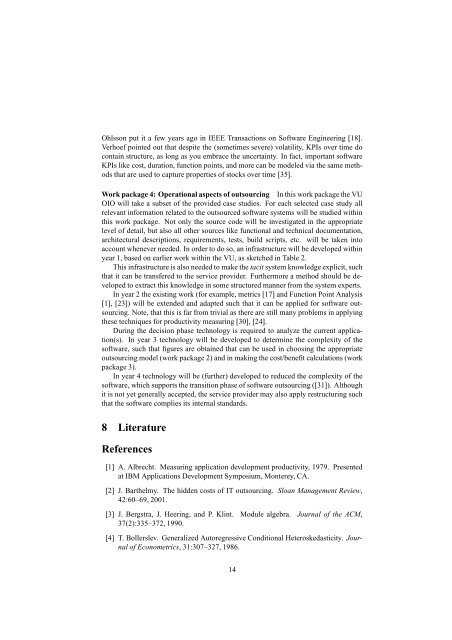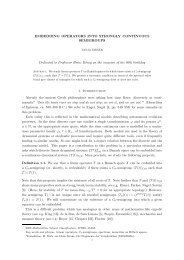Symbiosis - Universiteit van Amsterdam
Symbiosis - Universiteit van Amsterdam
Symbiosis - Universiteit van Amsterdam
You also want an ePaper? Increase the reach of your titles
YUMPU automatically turns print PDFs into web optimized ePapers that Google loves.
Ohlsson put it a few years ago in IEEE Transactions on Software Engineering [18].<br />
Verhoef pointed out that despite the (sometimes severe) volatility, KPIs over time do<br />
contain structure, as long as you embrace the uncertainty. In fact, important software<br />
KPIs like cost, duration, function points, and more can be modeled via the same methods<br />
that are used to capture properties of stocks over time [35].<br />
Work package 4: Operational aspects of outsourcing In this work package the VU<br />
OIO will take a subset of the provided case studies. For each selected case study all<br />
rele<strong>van</strong>t information related to the outsourced software systems will be studied within<br />
this work package. Not only the source code will be investigated in the appropriate<br />
level of detail, but also all other sources like functional and technical documentation,<br />
architectural descriptions, requirements, tests, build scripts, etc. will be taken into<br />
account whenever needed. In order to do so, an infrastructure will be developed within<br />
year 1, based on earlier work within the VU, as sketched in Table 2.<br />
This infrastructure is also needed to make the tacit system knowledge explicit, such<br />
that it can be transfered to the service provider. Furthermore a method should be developed<br />
to extract this knowledge in some structured manner from the system experts.<br />
In year 2 the existing work (for example, metrics [17] and Function Point Analysis<br />
[1], [23]) will be extended and adapted such that it can be applied for software outsourcing.<br />
Note, that this is far from trivial as there are still many problems in applying<br />
these techniques for productivity measuring [30], [24].<br />
During the decision phase technology is required to analyze the current application(s).<br />
In year 3 technology will be developed to determine the complexity of the<br />
software, such that figures are obtained that can be used in choosing the appropriate<br />
outsourcing model (work package 2) and in making the cost/benefit calculations (work<br />
package 3).<br />
In year 4 technology will be (further) developed to reduced the complexity of the<br />
software, which supports the transition phase of software outsourcing ([31]). Although<br />
it is not yet generally accepted, the service provider may also apply restructuring such<br />
that the software complies its internal standards.<br />
8 Literature<br />
References<br />
[1] A. Albrecht. Measuring application development productivity, 1979. Presented<br />
at IBM Applications Development Symposium, Monterey, CA.<br />
[2] J. Barthelmy. The hidden costs of IT outsourcing. Sloan Management Review,<br />
42:60–69, 2001.<br />
[3] J. Bergstra, J. Heering, and P. Klint. Module algebra. Journal of the ACM,<br />
37(2):335–372, 1990.<br />
[4] T. Bollerslev. Generalized Autoregressive Conditional Heteroskedasticity. Journal<br />
of Econometrics, 31:307–327, 1986.<br />
14

















